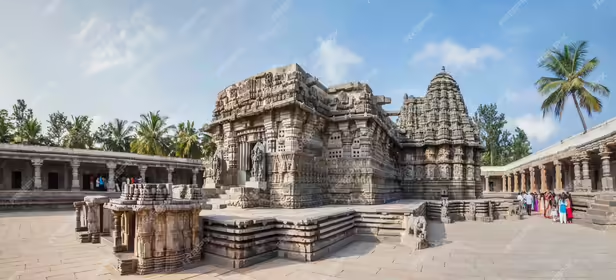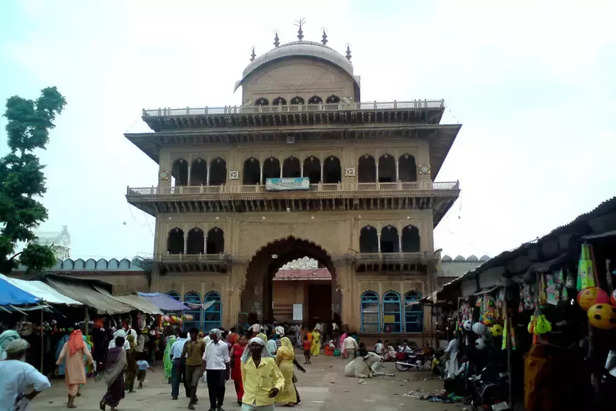India’s Lost Temples: The Ancient Sacred Sites You Never Knew Existed
Nidhi | Jan 09, 2025, 01:10 IST
Babri Masjid Demolition
India’s ancient temples, once bustling centers of worship and culture, have vanished over time due to invasions, destruction, and neglect. From the iconic Somnath Temple to the Keshava Deva Temple in Mathura, this article uncovers the stories of temples that were destroyed or lost to history. Learn about the historical significance of these sacred sites and their lasting influence on India’s spiritual and architectural heritage.
India, with its rich and diverse cultural history, is home to some of the world's most ancient and sacred temples. These temples, many of which were architectural marvels, stood as symbols of spiritual heritage, craftsmanship, and devotion. However, several of these sacred sites have vanished, either destroyed by invasions, natural calamities, or the passage of time. In this article, we explore some of these lost temples and their historical context, shedding light on their significance, the reasons for their destruction, and the present-day remnants or restorations.

The Keshava Deva Temple, located in the holy city of Mathura, is said to have been built by King Vajra, the great-grandson of Lord Krishna, and it stood as a prominent center of worship. The temple was dedicated to Lord Vishnu and was a site of great importance for pilgrims. In 1670, during the reign of Mughal Emperor Aurangzeb, the temple was demolished, and a mosque, the Idgah Mosque, was constructed on its ruins. This event is often cited as an example of the religious conflicts of that era. While the exact details of the temple’s destruction are debated, it is widely accepted that the temple was dismantled by imperial forces. In the modern day, efforts to rebuild the temple have faced challenges due to the mosque’s presence.
The Somnath Temple, located in the coastal region of Saurashtra, Gujarat, is dedicated to Lord Shiva and is one of the twelve Jyotirlingas, making it one of the most revered pilgrimage sites for Hindus. The temple has faced several attacks over the centuries. The first major attack occurred in 1025 CE when the temple was plundered and destroyed by Mahmud of Ghazni, a ruler from present-day Afghanistan. Mahmud's forces looted the temple’s treasures, and the temple was left in ruins. The temple was rebuilt multiple times, and in 1783, the Maratha ruler, Mahadji Shinde, restored it. The current structure was rebuilt in the 1950s by the Government of India, symbolizing the nation’s commitment to preserving its spiritual heritage.
The Vishwanath Temple, dedicated to Lord Shiva, has stood as a symbol of devotion for centuries in the city of Varanasi, one of the oldest living cities in the world. The temple has been destroyed and rebuilt several times. The first known destruction occurred in 1194 CE when the temple was attacked by Qutb-ud-Din Aibak, a general under the Delhi Sultanate. Later, under Mughal Emperor Aurangzeb, the original temple was once again demolished, and a mosque, known as the Gyanvapi Mosque, was constructed on the site. Despite these setbacks, the temple was rebuilt in the 18th century by the Maratha rulers, particularly Maharani Ahilyabai Holkar, who also rebuilt other important temples across India. The Vishwanath Temple stands today as one of the most important sites for Shaivite worship.
Nalanda, the ancient center of learning, was one of the oldest universities in the world, attracting scholars from across Asia. Located in present-day Bihar, the university was not only a beacon of intellectual pursuit but also housed several temples dedicated to Hindu and Buddhist deities. The university, along with its temples, was destroyed in the 12th century by the forces of Bakhtiyar Khilji. The invaders set fire to the massive library, causing a significant loss of knowledge. The destruction of Nalanda was a blow not just to the educational system but also to the rich cultural and spiritual heritage of India. Today, the ruins of Nalanda are a UNESCO World Heritage Site, standing as a testament to the destruction wrought during that time.

The Sun Temple in Konark, Odisha, is a UNESCO World Heritage Site and one of the finest examples of ancient Indian architecture. Dedicated to Surya, the Sun God, the temple is designed in the shape of a massive chariot, with twelve wheels and seven horses. It was built in the 13th century by King Narasimhadeva I of the Eastern Ganga Dynasty. However, the temple faced severe damage in the 16th century when the forces of Kalapahad, a general under the Bengal Sultanate, attacked and looted the temple. Many of the temple’s sculptures were destroyed or taken away, and parts of the structure were dismantled. Today, the ruins of the Sun Temple stand as a symbol of the artistic brilliance of ancient India, though much of its former grandeur has been lost.

The Sri Ranganathaswamy Temple in Srirangam, Tamil Nadu, is one of the largest functioning temples in India and a significant site for followers of the Vaishnavite tradition. The temple has witnessed multiple invasions over the centuries, notably during the 14th century when the Delhi Sultanate forces damaged several parts of the temple. Despite the destruction, the temple’s core structure survived, and it was restored over time. The temple remains one of the most important pilgrimage sites in South India, representing the resilience of Indian spiritual heritage.
The Nataraja Temple in Chidambaram, Tamil Nadu, is dedicated to Lord Shiva in his form as the Cosmic Dancer. This temple has endured several invasions, including the famous attack by Malik Kafur, a general under Alauddin Khilji, in the 14th century. While the temple suffered considerable damage, it was later restored and continues to serve as a vital center of worship and culture. The temple is celebrated for its unique architectural features, such as the Chidambara Rahasya, the secret space where the divine dance of Lord Shiva is symbolized.
Many of these sacred temples have either been rebuilt or remain as ruins today, reflecting the indomitable spirit of resilience in the face of adversity. While the destruction of these temples is a significant part of Indian history, it is important to acknowledge the cultural continuity and the preservation efforts that followed. India’s heritage is a blend of diverse traditions, and these temples, despite their challenges, continue to symbolize the nation's spiritual and cultural richness. The journey of these sacred sites—from grandeur to destruction and eventual restoration—is a testament to the enduring nature of faith, culture, and heritage in India.
1. Keshava Deva Temple, Mathura

Keshava Deva Temple
The Keshava Deva Temple, located in the holy city of Mathura, is said to have been built by King Vajra, the great-grandson of Lord Krishna, and it stood as a prominent center of worship. The temple was dedicated to Lord Vishnu and was a site of great importance for pilgrims. In 1670, during the reign of Mughal Emperor Aurangzeb, the temple was demolished, and a mosque, the Idgah Mosque, was constructed on its ruins. This event is often cited as an example of the religious conflicts of that era. While the exact details of the temple’s destruction are debated, it is widely accepted that the temple was dismantled by imperial forces. In the modern day, efforts to rebuild the temple have faced challenges due to the mosque’s presence.
2. Somnath Temple, Saurashtra
3. Vishwanath Temple, Varanasi
4. Nalanda University and Its Temples
5. Sun Temple, Konark

Sun Temple
The Sun Temple in Konark, Odisha, is a UNESCO World Heritage Site and one of the finest examples of ancient Indian architecture. Dedicated to Surya, the Sun God, the temple is designed in the shape of a massive chariot, with twelve wheels and seven horses. It was built in the 13th century by King Narasimhadeva I of the Eastern Ganga Dynasty. However, the temple faced severe damage in the 16th century when the forces of Kalapahad, a general under the Bengal Sultanate, attacked and looted the temple. Many of the temple’s sculptures were destroyed or taken away, and parts of the structure were dismantled. Today, the ruins of the Sun Temple stand as a symbol of the artistic brilliance of ancient India, though much of its former grandeur has been lost.
6. Sri Ranganathaswamy Temple, Srirangam (Damaged but Survived)

Sri Ranganathaswamy Temple
The Sri Ranganathaswamy Temple in Srirangam, Tamil Nadu, is one of the largest functioning temples in India and a significant site for followers of the Vaishnavite tradition. The temple has witnessed multiple invasions over the centuries, notably during the 14th century when the Delhi Sultanate forces damaged several parts of the temple. Despite the destruction, the temple’s core structure survived, and it was restored over time. The temple remains one of the most important pilgrimage sites in South India, representing the resilience of Indian spiritual heritage.
